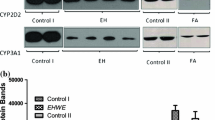Abstract
Carbamazepine (CBZ), an antiepileptic with narrow therapeutic window, is a substrate of CYP 3A4 which metabolizes CBZ to carbamazepine-10,11-epoxide (CBZE). CBZE is an active and toxicity metabolite, and it is a substrate of MRP-2. Using CBZ for a long time can cause hepatic injury. Sophora flavescens (SF) is a medicinal herb used for the protected hepatic injury. This study investigated the acute and chronic effects of SF on the pharmacokinetics of CBZ in rats. The concentrations of CBZ and CBZE in plasma and tissues were determined by HPLC method. The results showed that SF which significantly decreased the AUC0-t of CBZ, increased CBZE conversely. Tissue analysis showed that the concentrations of CBZ and CBZE in brain and liver were decreased by SF. In addition, the distribution of CBZE in kidney was reduced significantly, which influenced the CBZE excretion and increased the drug toxic potentially. Results in the current study suggest that patients using CBZ might be cautioned in the use of SF extract or Sophora-derived products. Meanwhile, patients receiving drugs which are substrates of CYP 3A4 and/or MRP-2 should be advised of the potential herb–drug interaction to reduce the risk of therapeutic failure or increased toxicity of conventional drug therapy.



Similar content being viewed by others
References
Chai, N.L., F. Qiang, S. Hui, C.H. Cai, W. Jun, S.P. Xu, and B.Y. Wu. 2012. Oxymatrine liposome attenuates hepatic fibrosis via targeting hepatic stellate cells. World Journal of Gastroenterology 31: 4199–4206.
Cheng, H., X. Bing, and L. Zhang. 2006. Matrine improves 2,4,6-trinitrobenzene sulfonic acid-induced colitis in mice. Pharmacological Research 53: 202–208.
Chi, Y.C., S.P. Lin, and Y.C. Hou. 2012. A new herb–drug interaction of Polygonum cuspidatum, a resveratrol-rich nutraceutical, with carbamazepine in rats. Toxicology and Applied Pharmacology 263: 315–322.
Eisenberg, D.M., R.B. Davis, S.L. Ettner, S. Appel, S. Wilkey, M. Van Rompay, and R.C. Kessler. 1998. Trends in alternative medicine use in the United States, 1990–1997: Results of a follow-up national survey. Journal of the American Medical Association 280: 1569–1575.
Faigle, J.W., and K.F. Feldman. 1995. Carbamazepine: Chemistry and biotransformation. In Antiepileptic Drugs, 4th ed, ed. R.H. Levy, R.H. Mattson, and B.S. Meldrum, 499–513. New York: Raven Press.
Hitomi, Y., H. Teruki, H. Masayuki, and H. Tyuji. 2012. Prediction of sites of metabolism in a substrate molecule, instanced by carbamazepine oxidation by CYP3A4. Bioorganic & Medicinal Chemistry 20: 775–783.
Hu, Z.L., J.P. Zhang, D.H. Qian, W. Lin, W.F. Xie, X.R. Zhang, and W.Z. Chen. 1996. Effects of matrine on mouse splenocyte proliferation and release of interleukin-1 and -6 from peritoneal macrophages in vitro. Acta Pharmacologica Sinica 17: 259–261.
Kerr, B.M., K.E. Thummel, C.J. Wurden, S.M. Klein, D.L. Kroetz, F.J. Gonzalez, and R.H. Levy. 1994. Human liver carbamazepine metabolism. Role of CYP3A4 and CYP2C8 in 10,11-epoxide formation. Biochemical Pharmacology 47: 169–179.
Li, Y.W., Y. Hui, Y.M. Xing, H.Y. Sun, Z.Y. Pan, and G.R. Xie. 2010. Oxymatrine inhibits development of morphine-induced tolerance associated with decreased. Integrative Cancer Therapies 9: 213–217.
Nakasa, H., M. Komiya, S. Ohmori, T. Rikihisa, M. Kiuchi, and M. Kitada. 1993. Characterization of human liver microsomal cytochrome P450 involved in the reductive metabolism of zonisamide. Molecular Pharmacology 44: 216–221.
Nakasa, H., H. Nakamura, S. Ono, M. Tsutsui, M. Kiuchi, S. Ohmori, and M. Kitada. 1998. Prediction of drug–drug interactions of zonisamide metabolism in humans from in vitro data. European Journal of Clinical Pharmacology 54: 177–183.
Roujeau, J.C., J.P. Kelly, L. Naldi, B. Rzany, R.S. Stern, T. Anderson, A. Auquier, S. Bastuji-Garin, O. Correia, and F. Locati. 1995. Medication use and the risk of Stevens–Johnson syndrome or toxic epidermal necrolysis. New England Journal of Medicine 333: 1600–1607.
Sullivan, F.M., and P.R. McElhatton. 1977. A comparison of the teratogenic activity of the antiepileptic drugs carbamazepine, clonazepam, ethosuximide, phenobarbital, phenytoin, and primidone in mice. Toxicology and Applied Pharmacology 40: 365–378.
Tan, H.R., and B.H. Zhang. 1985. Experimental study of the anti-inflammatory effect of matrine. Chinese Journal of Modern Developments in Traditional Medicine 5: 108–109.
Uenga, Y.F., C.C. Chen, C.C. Tsai, and S. Pavel. 2009. Differential inductive profiles of hepatic cytochrome P450s by the extracts of Sophora flavescens in male and female C57BL/6JNarl mice. Journal of Ethnopharmacology 126: 437–446.
Wang, Y.P., Z. Wei, X. Rong, Z.X. Zhou, Liua Fei, Y.X. Han, R. Gang, Z.G. Peng, C. Shan, H.S. Chen, Y.H. Li, and J.D. Jiang. 2011. Oxymatrine inhibits hepatitis B infection with an advantage of overcoming drug-resistance. Antiviral Research 89: 227–231.
Wu, X.L., W.Z. Zeng, M.D. Jiang, J.P. Qin, and Hui Xu. 2008. Effect of Oxymatrine on the TGF beta-Smad signaling pathway in rats with CCl4-induced hepatic fibrosis. World Journal of Gastroenterology 14: 2100–2105.
Author information
Authors and Affiliations
Corresponding author
Rights and permissions
About this article
Cite this article
Shi, L., Dang, XL., Liu, XY. et al. Effect of Sophora flavescens on the pharmacokinetics of carbamazepine in rats. Arch. Pharm. Res. 37, 1617–1623 (2014). https://doi.org/10.1007/s12272-014-0375-8
Received:
Accepted:
Published:
Issue Date:
DOI: https://doi.org/10.1007/s12272-014-0375-8




